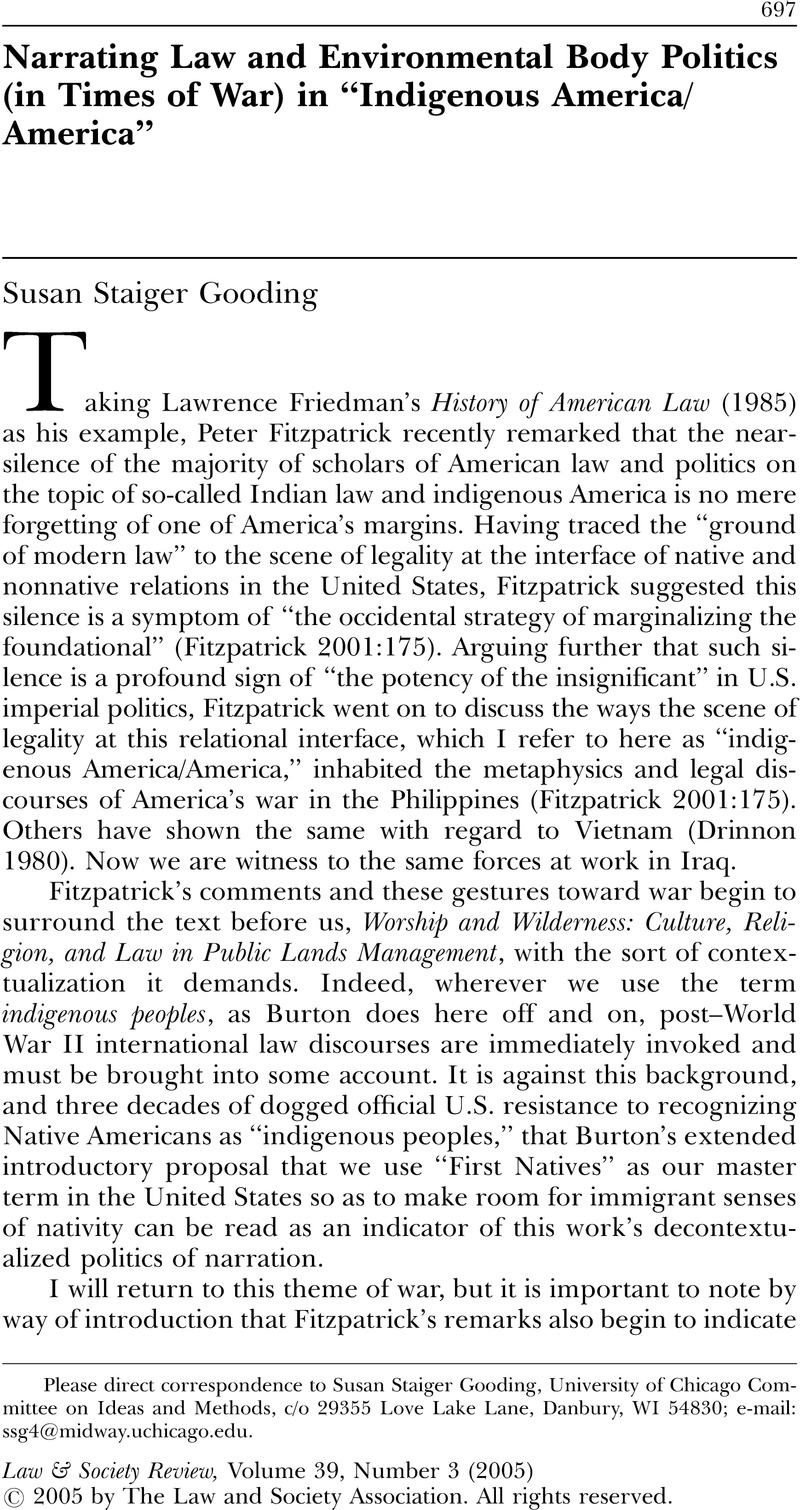No CrossRef data available.
Article contents
Narrating Law and Environmental Body Politics (in Times of War) in “Indigenous America/America”
Published online by Cambridge University Press: 01 January 2024
Abstract
An abstract is not available for this content so a preview has been provided. Please use the Get access link above for information on how to access this content.

- Type
- Research Article
- Information
- Copyright
- © 2005 Law and Society Association.
References
References
Borrows, John (1997) “Living Between Water and Rocks: First Nations, Environmental Planning and Democracy,” 47 University of Toronto Law J. 417–68.CrossRefGoogle Scholar
Churchill, Ward (1998) “The Tragedy and the Travesty: The Subversion of Indigenous Sovereignty in North America,” 22 American Indian Culture and Research J. 1–69.CrossRefGoogle Scholar
Churchill, Ward, & LaDuke, Winona (1992) “Native North America: The Political Economy of Radioactive Colonialism,” in Jaimes, M. A., ed., The State of Native America: Genocide, Colonization, and Resistance. Boston: South End Press.Google Scholar
Comaroff, John (1996) “Ethnicity, Nationalism, and the Politics of Difference in an Age of Revolution,” in Wilmsen, E. N. & McAllister, P., eds., The Politics of Difference: Ethnic Premises in a World of Power. Chicago: Univ. of Chicago Press.Google Scholar
Deloria, Vine Jr. (1992) “Trouble in High Places: Erosion of American Indian Rights to Religious Freedom in the United States,” in Jaimes, M. A., ed., The State of Native America: Genocide, Colonization, and Resistance. Boston: South End Press.Google Scholar
Dombrowski, Kirk (2002) “The Praxis of Indigenism and Alaska Native Timber Politics,” 104 American Anthropologist 1062–73.CrossRefGoogle Scholar
Drinnon, Richard (1980) Facing West: Indian Hating and Empire-Building. New York: Schocken Books.Google Scholar
Fitzpatrick, Peter (2001) Modernism and the Ground of Law. Cambridge: Cambridge Univ. Press.CrossRefGoogle Scholar
Gedicks, Al (1993) The New Resource Wars: Native and Environmental Struggles Against Multinational Corporations. Boston: South End Press.Google Scholar
Merry, Sally Engel (1992) “Anthropology, Law, and Transnational Processes,” 21 Annual Rev. of Anthropology 375–9.CrossRefGoogle Scholar
Merry, Sally Engel (1998) “Law, Culture, and Cultural Appropriation,” 10 Yale Law Rev. 575–603.Google Scholar
O'Neil, Dan (1998) “Alaska and the Firecracker Boys: The Story of Project Chariot,” in Hevly, B. & Findlay, J. M., eds., The Atomic West. Seattle: Univ. of Washington Press.Google Scholar
Robbins, Rebecca L. (1992) “Self-Determination and Subordination: The Past, Present, and Future of American Indian Governance,” in Jaimes, M. A., ed., The State of Native America: Genocide, Colonization, and Resistance. Boston: South End Press.Google Scholar
Williams, Robert A. (1994) “Large Binocular Telescopes, Red Squirrel Pinatas, and Apache Sacred Mountains: Decolonizing Environmental Law in a Multicultural World,” 96 West Virginia Law Rev. 1133–64.Google Scholar
Wilson, Richard A. (1997) “Human Rights, Culture and Context: An Introduction,” in Wilson, R. A., ed., Human Rights, Culture and Context: Anthropological Perspectives. London: Pluto Press.Google Scholar
Young, Iris Marion (2002) “Two Concepts of Self-Determination,” in Sarat, A. & Kearns, T. R., eds., Human Rights: Concepts, Contests, Contingencies. Ann Arbor: Univ. of Michigan Press.Google Scholar
Case Cited
Lyng v. Northwest Indian Cemetery Protective Association, 458 U.S. 439, 99 L.Ed. 2d 534 (1988).Google Scholar


